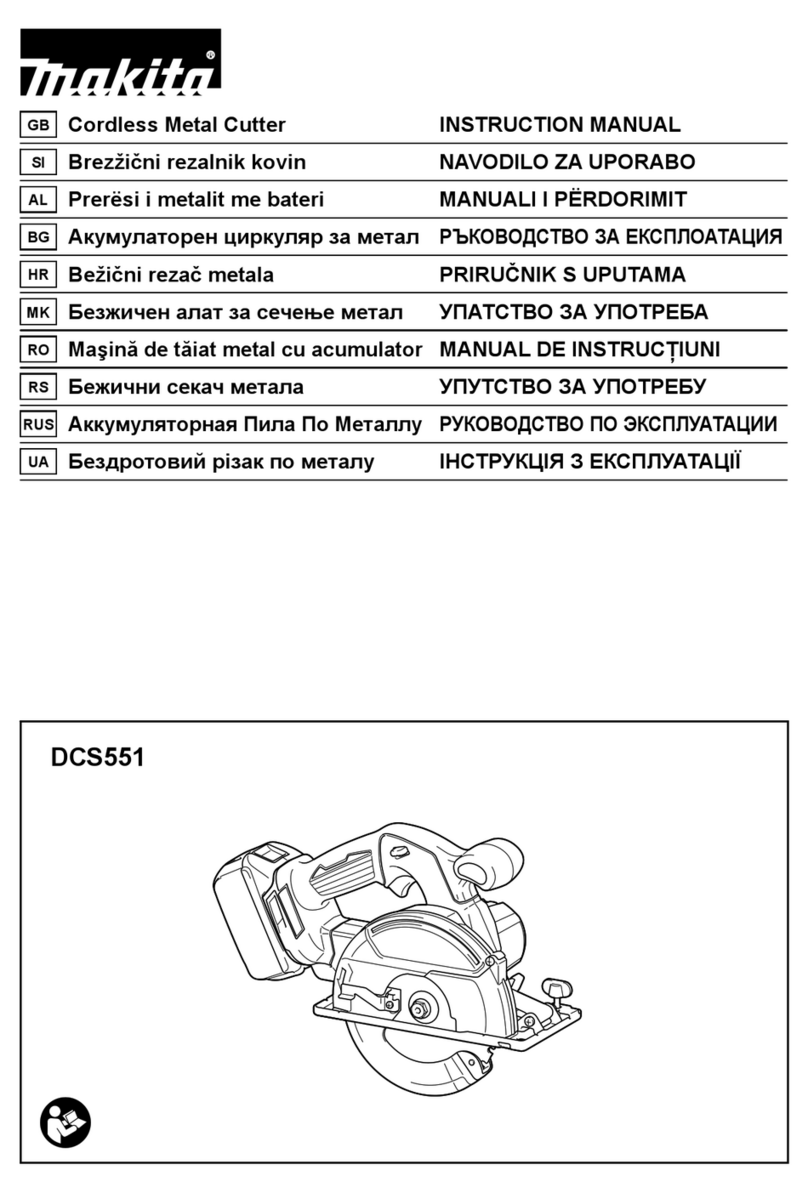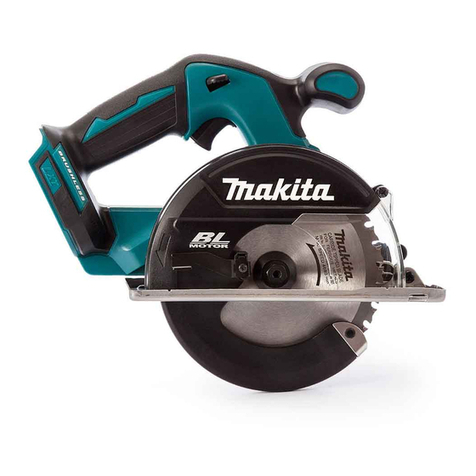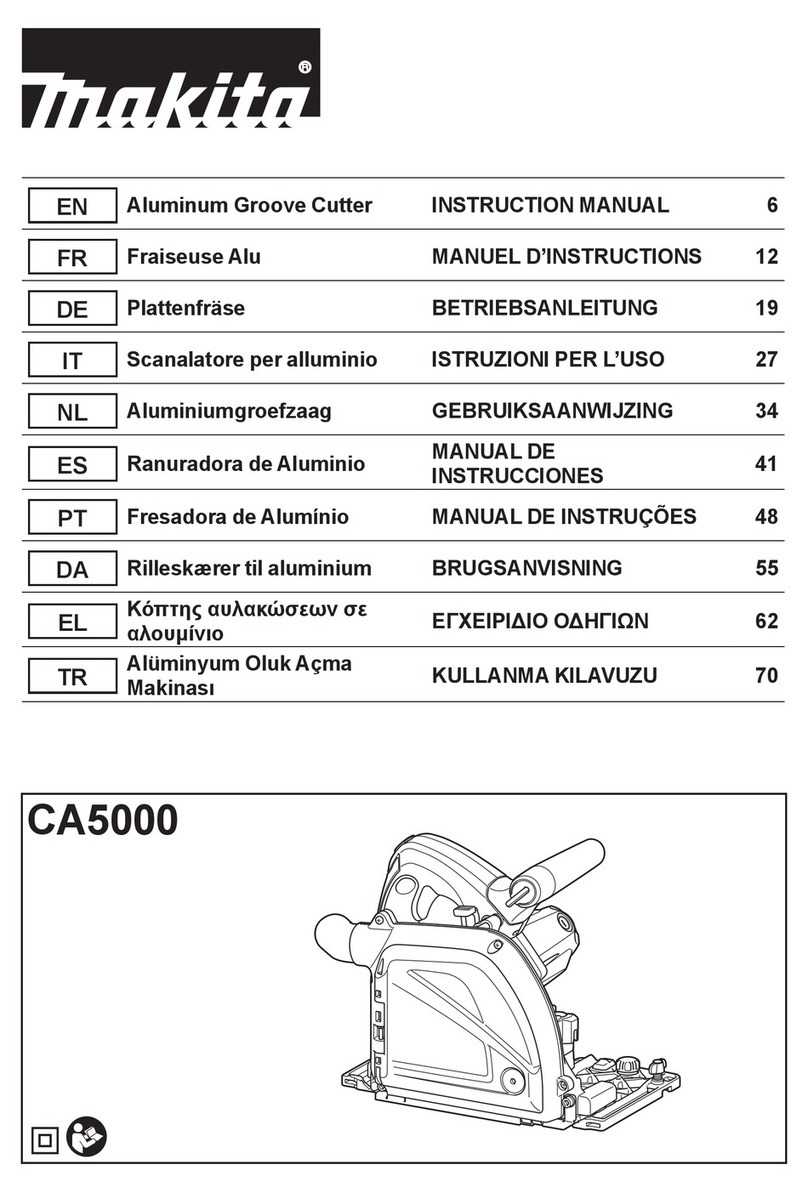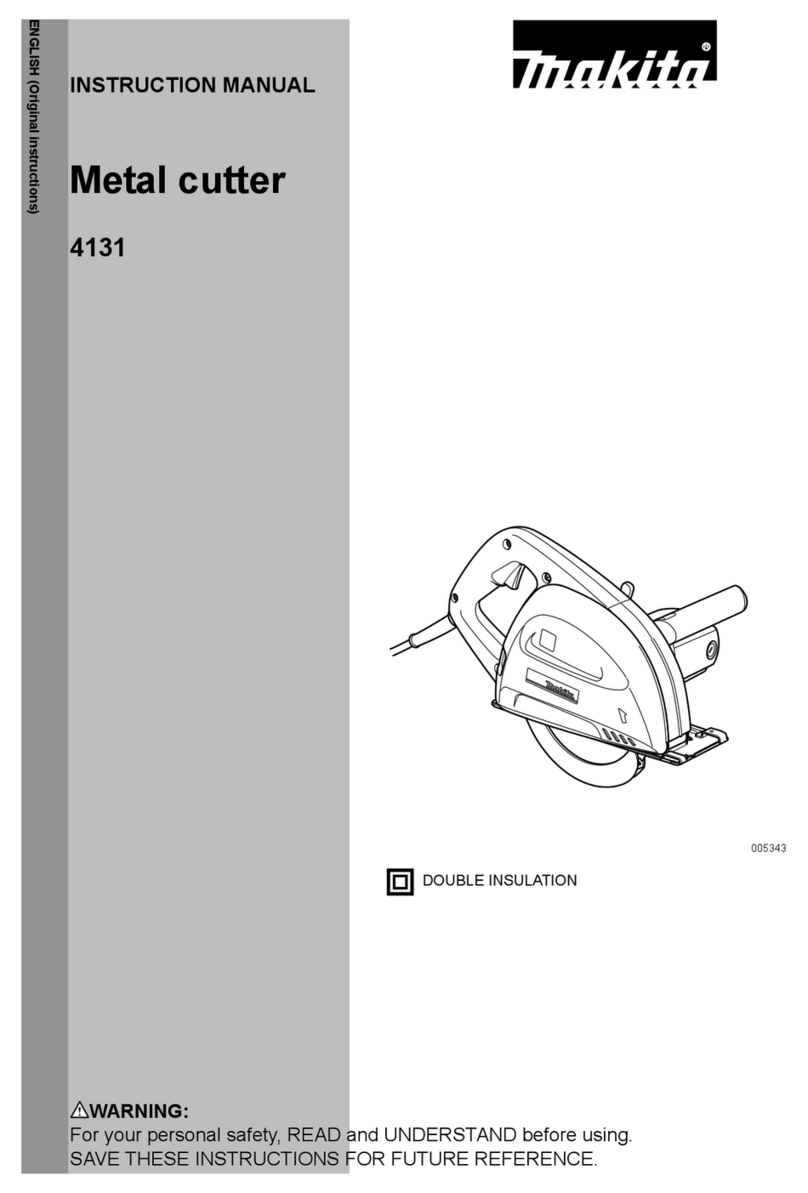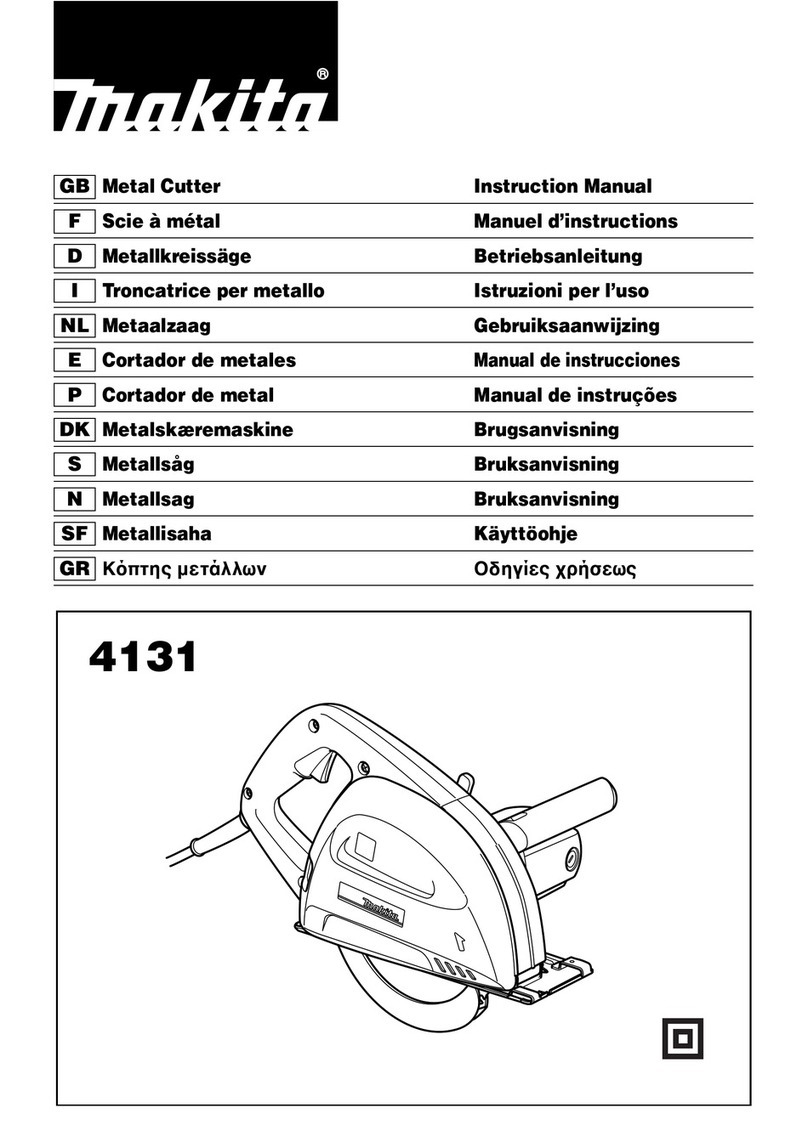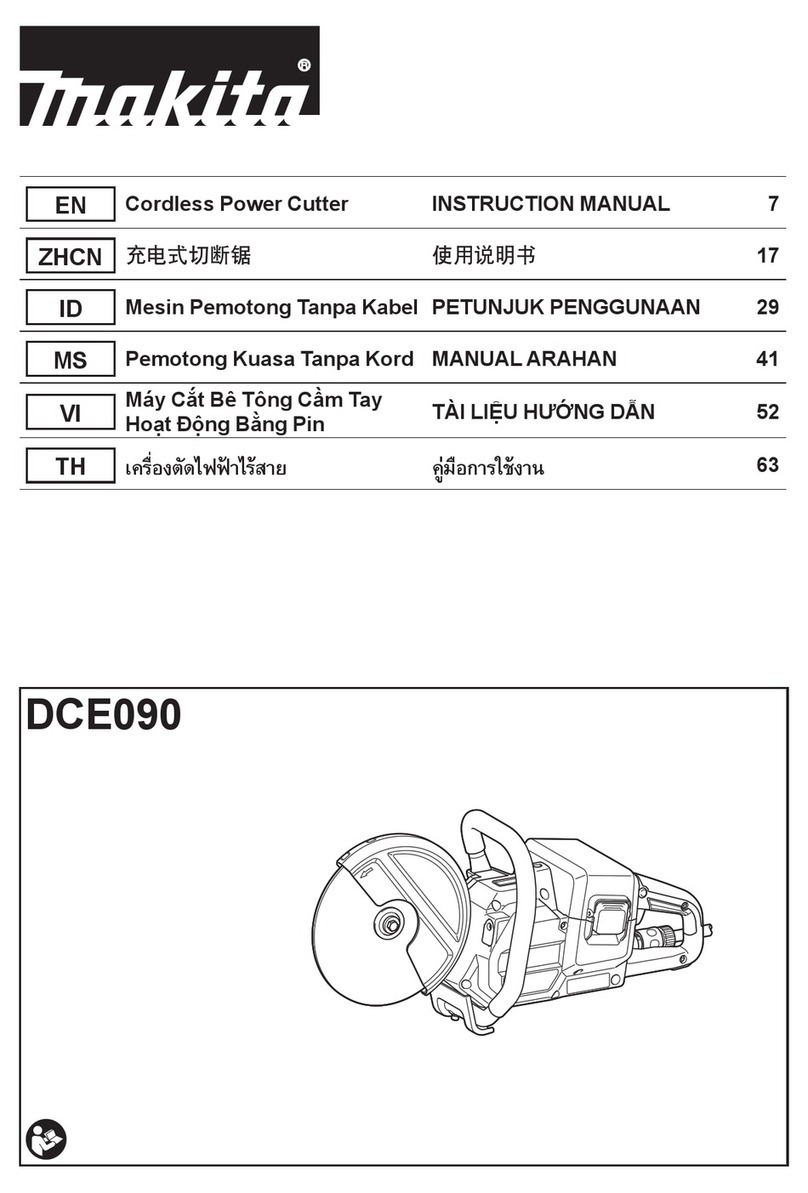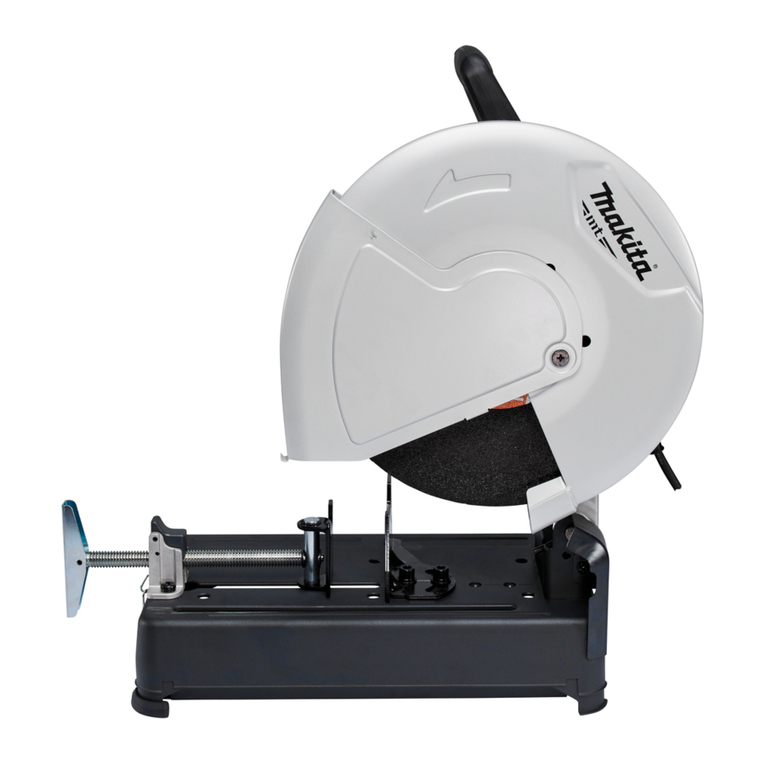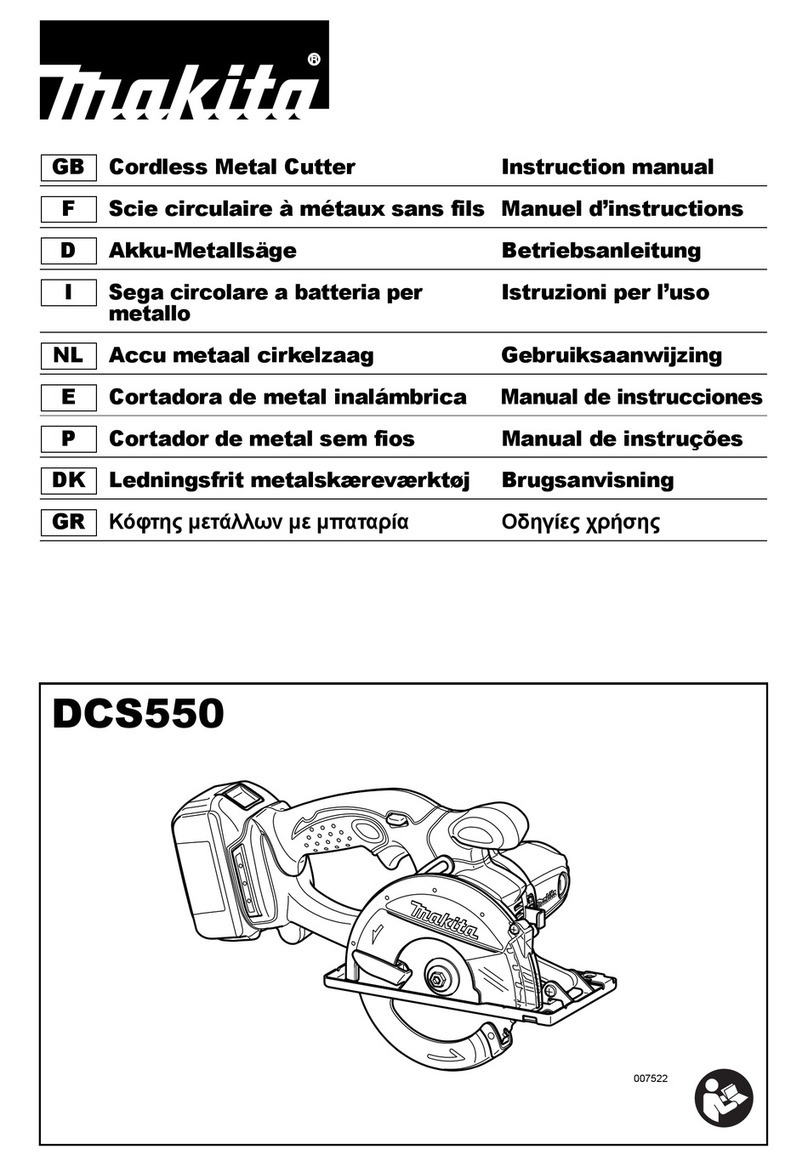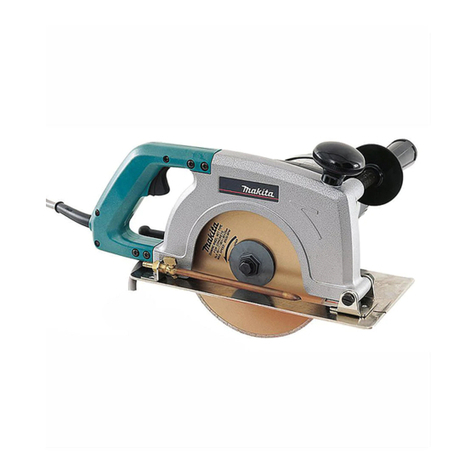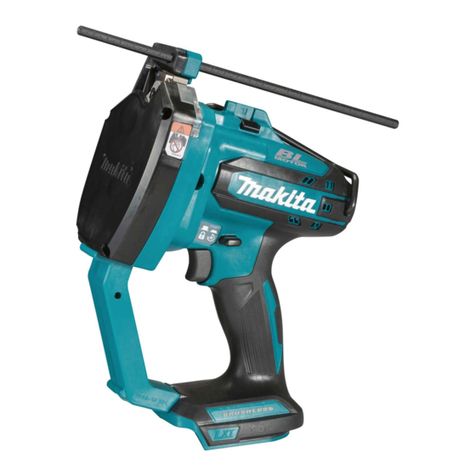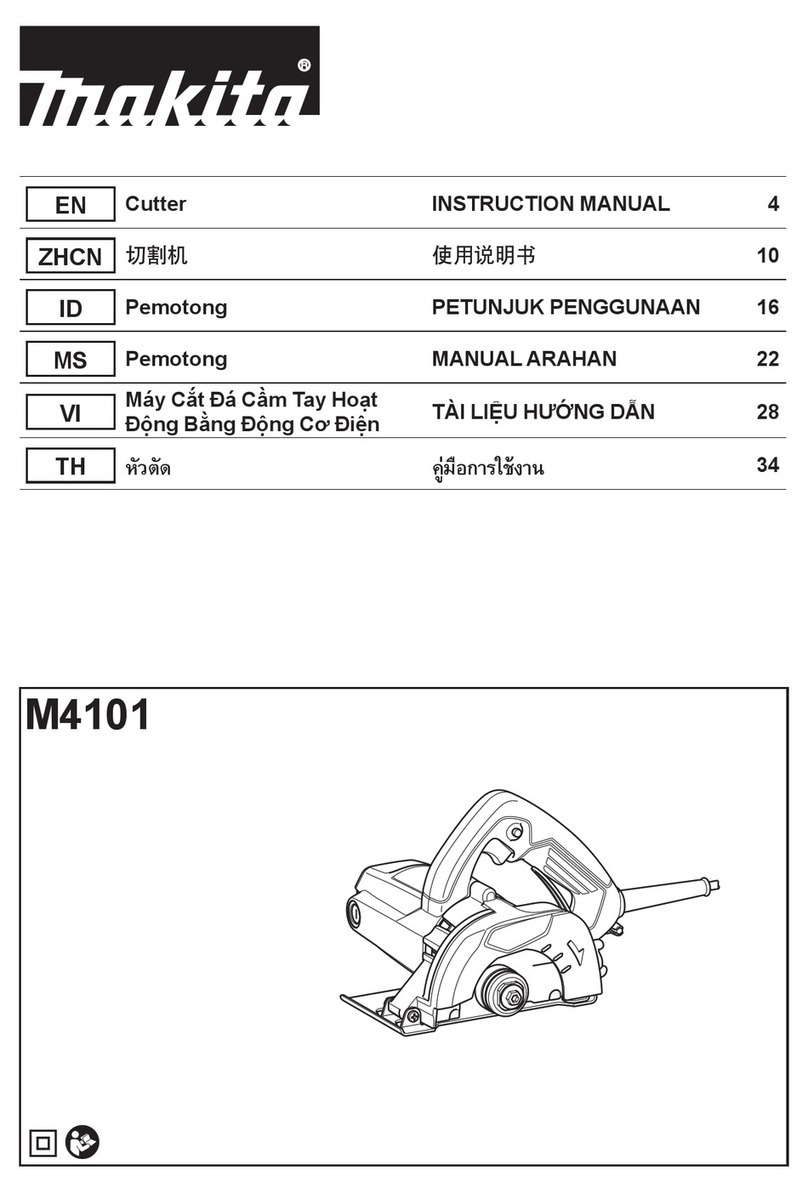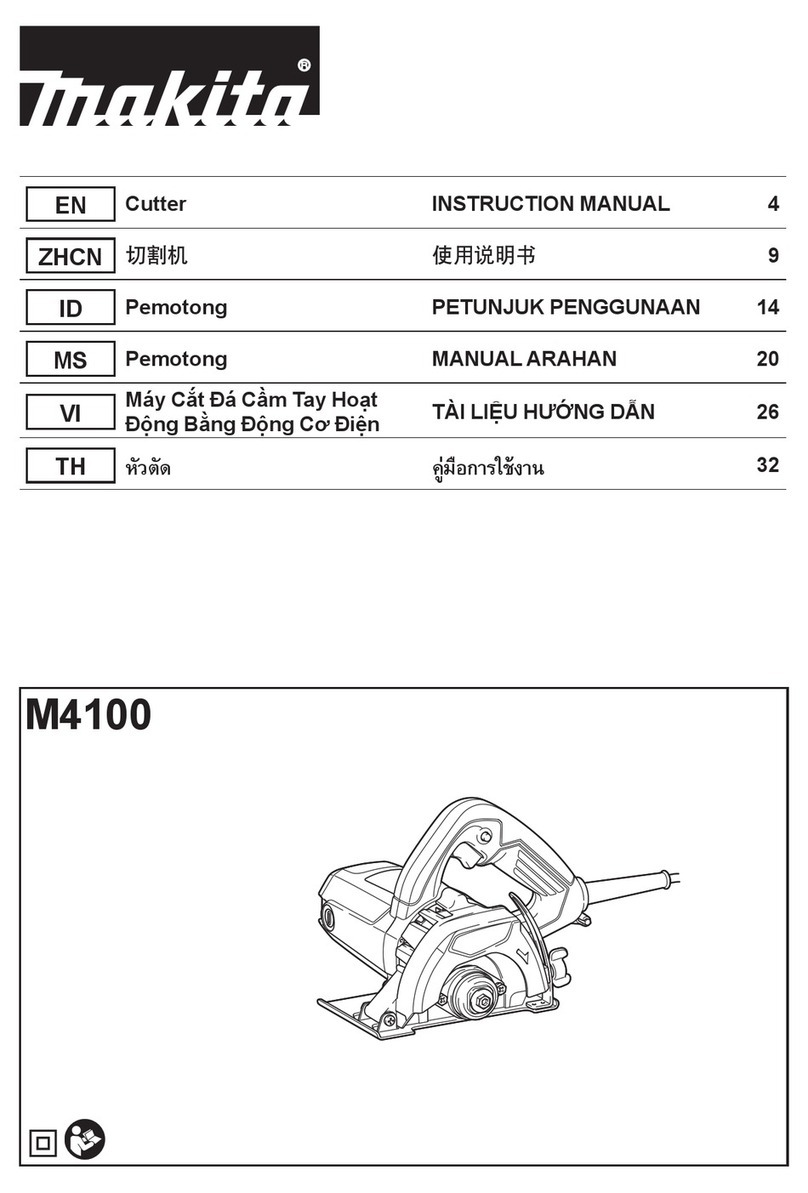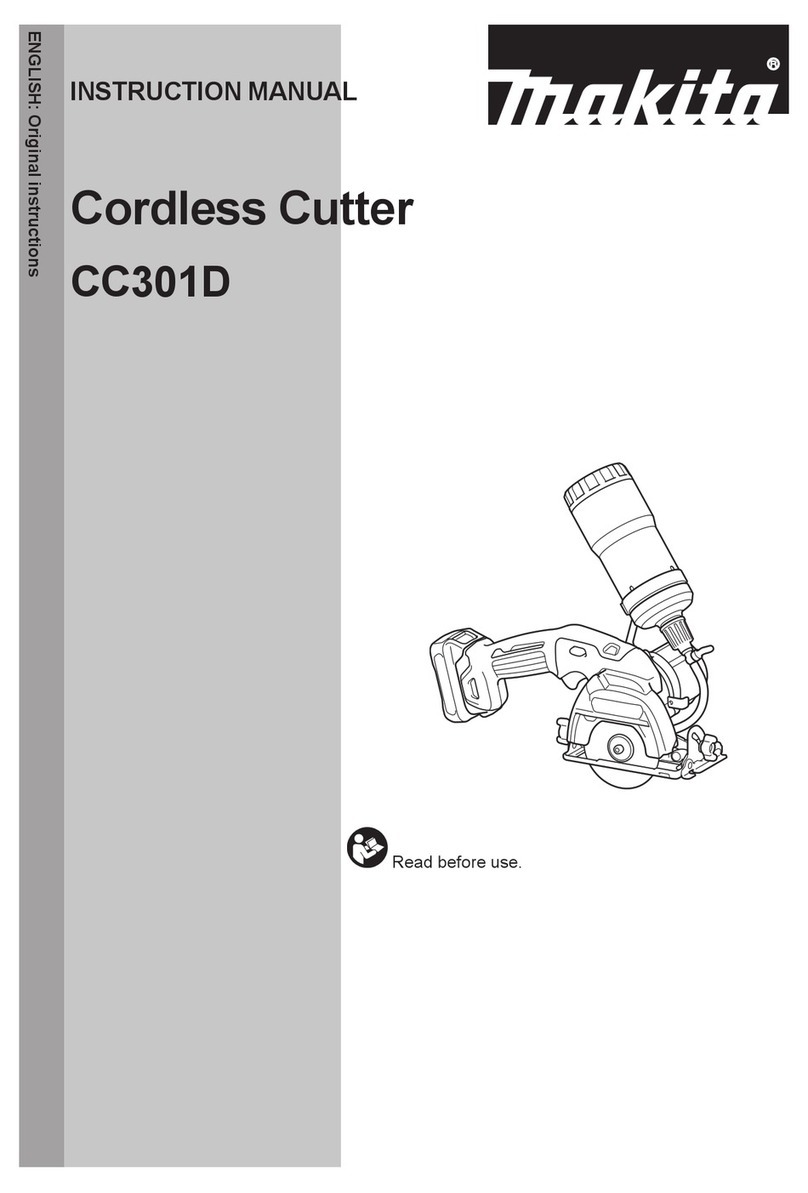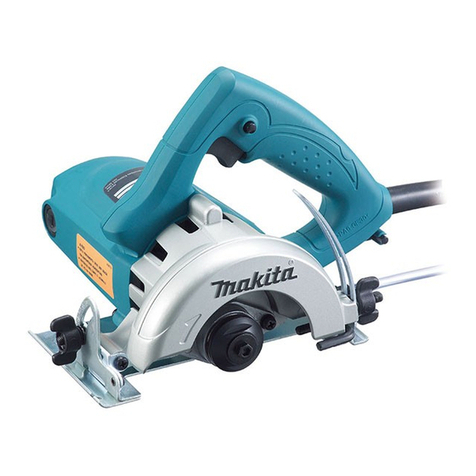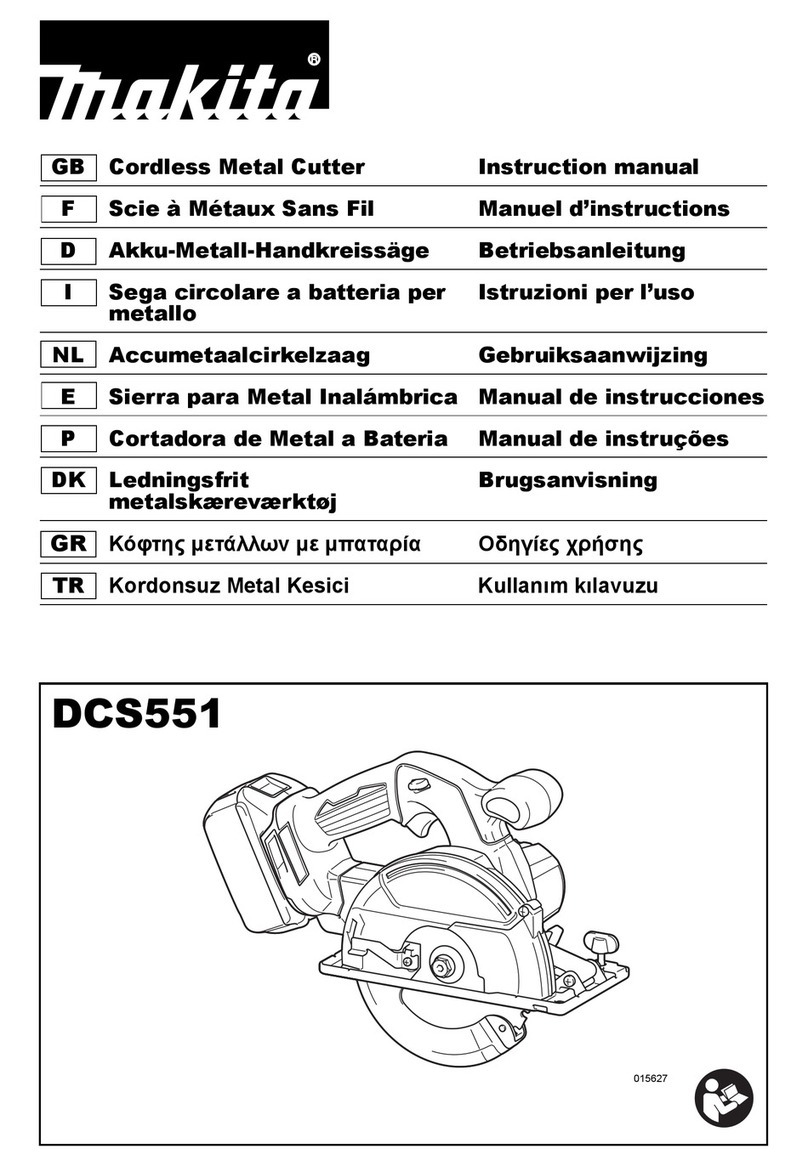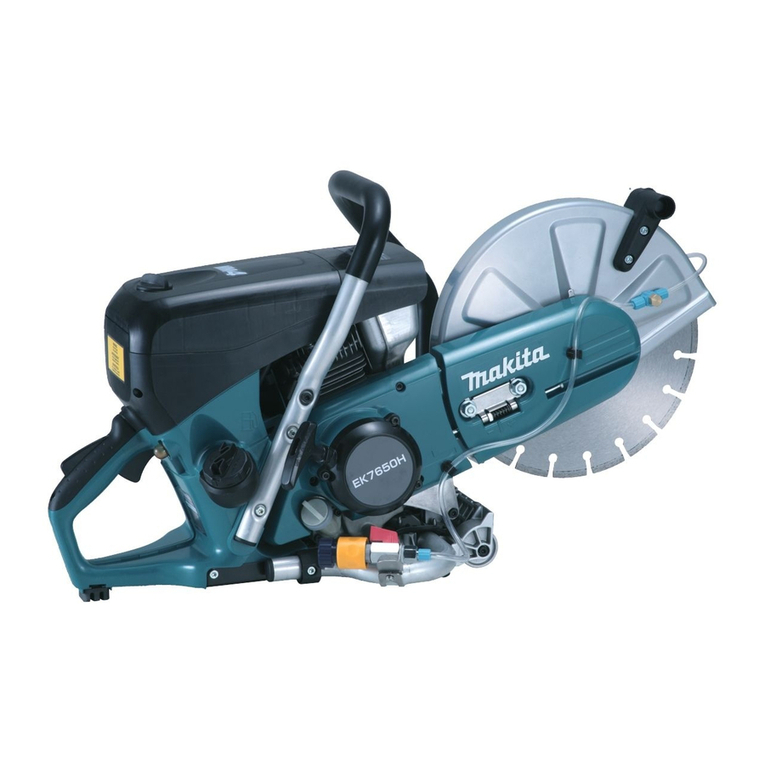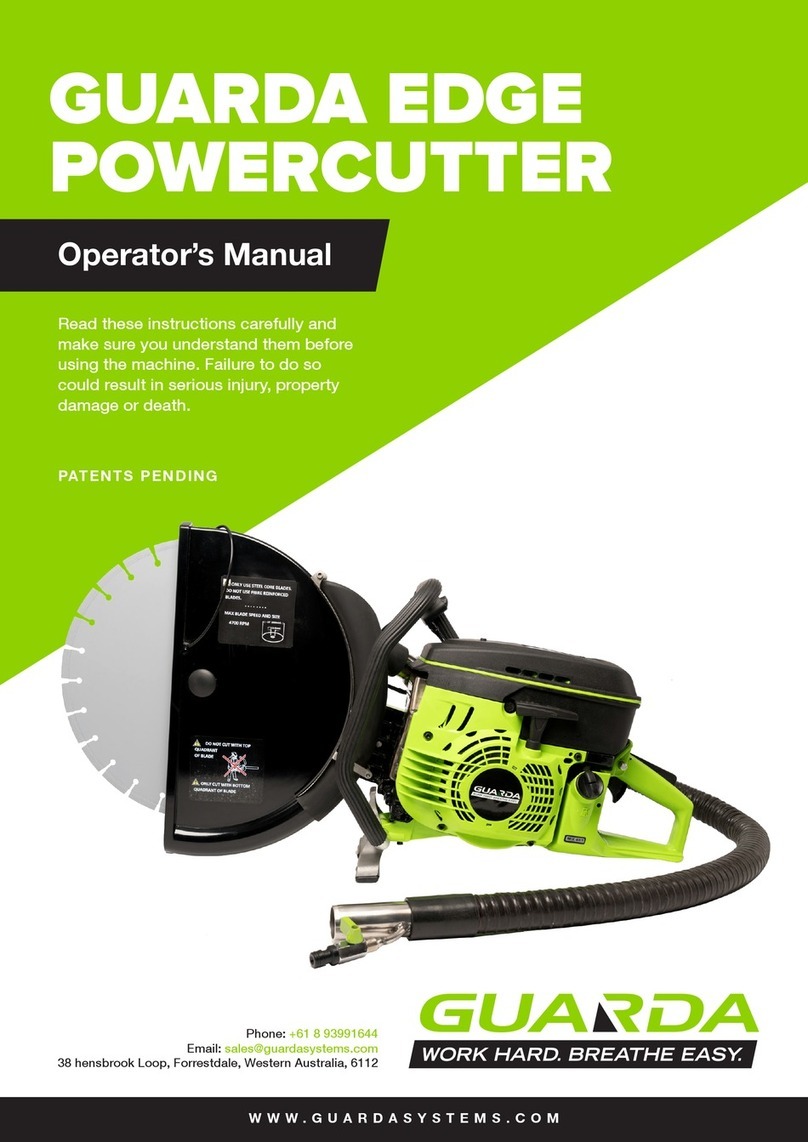
5ENGLISH
12.
Hold the power tool by insulated gripping sur-
faces only, when performing an operation where
the cutting accessory may contact hidden wir-
ing.Cuttingaccessorycontactinga“live”wiremay
makeexposedmetalpartsofthepowertool“live”
and could give the operator an electric shock.
13. Never lay the power tool down until the acces-
sory has come to a complete stop. The spinning
wheelmaygrabthesurfaceandpullthepower
tooloutofyourcontrol.
14. Do not run the power tool while carrying it at
your side. Accidental contact with the spinning
accessorycouldsnagyourclothing,pullingthe
accessoryintoyourbody.
15. Regularly clean the power tool’s air vents. The
motor’s fan will draw the dust inside the housing
and excessive accumulation of powdered metal
maycauseelectricalhazards.
16. Do not operate the power tool near ammable
materials. Sparks could ignite these materials.
Kickback and related warnings
Kickback is a sudden reaction to a pinched or snagged
rotating wheel. Pinching or snagging causes rapid stalling
of the rotating wheel which in turn causes the uncon-
trolled power tool to be forced in the direction opposite of
the wheel’s rotation at the point of the binding.
For example, if an abrasive wheel is snagged or
pinchedbytheworkpiece,theedgeofthewheelthatis
entering into the pinch point can dig into the surface of
the material causing the wheel to climb out or kick out.
Thewheelmayeitherjumptowardorawayfromthe
operator, depending on direction of the wheel’s move-
mentatthepointofpinching.Abrasivewheelsmayalso
break under these conditions.
Kickback is the result of power tool misuse and/or
incorrect operating procedures or conditions and can be
avoidedbytakingproperprecautionsasgivenbelow.
1. Maintain a rm grip on the power tool and
position your body and arm to allow you to
resist kickback forces. Always use auxiliary
handle, if provided, for maximum control over
kickback or torque reaction during start-up.
The operator can control torque reactions or kick-
back forces, if proper precautions are taken.
2. Never place your hand near the rotating acces-
sory.Accessorymaykickbackoveryourhand.
3. Do not position your body in line with the
rotating wheel. Kickback will propel the tool in
direction opposite to the wheel’s movement at the
point of snagging.
4. Use special care when working corners, sharp
edges etc. Avoid bouncing and snagging the
accessory. Corners, sharp edges or bouncing
haveatendencytosnagtherotatingaccessory
and cause loss of control or kickback.
5.
Do not attach a saw chain, woodcarving blade,
segmented diamond wheel with a peripheral gap
greater than 10 mm or toothed saw blade. Such
blades create frequent kickback and loss of control.
6. Do not “jam” the wheel or apply excessive
pressure. Do not attempt to make an excessive
depth of cut. Overstressing the wheel increases
theloadingandsusceptibilitytotwistingorbinding
ofthewheelinthecutandthepossibilityofkick-
back or wheel breakage.
7. When wheel is binding or when interrupting
a cut for any reason, switch o the power
tool and hold the power tool motionless until
the wheel comes to a complete stop. Never
attempt to remove the wheel from the cut while
the wheel is in motion otherwise kickback may
occur. Investigate and take corrective action to
eliminate the cause of wheel binding.
8. Do not restart the cutting operation in the
workpiece. Let the wheel reach full speed and
carefully re-enter the cut.Thewheelmaybind,
walk up or kickback if the power tool is restarted in
the workpiece.
9. Support panels or any oversized workpiece to
minimize the risk of wheel pinching and kick-
back. Large workpieces tend to sag under their
own weight. Supports must be placed under the
workpiece near the line of cut and near the edge
of the workpiece on both sides of the wheel.
10. Use extra caution when making a “pocket cut”
into existing walls or other blind areas. The
protrudingwheelmaycutgasorwaterpipes,elec-
tricalwiringorobjectsthatcancausekickback.
Additional Safety Warnings:
1. Before using a segmented diamond wheel,
make sure that the diamond wheel has the
peripheral gap between segments of 10 mm or
less, only with a negative rake angle.
2. Never attempt to cut with the tool held upside
down in a vise. This can lead to serious acci-
dents, because it is extremely dangerous.
3. Some material contains chemicals which may
be toxic. Take caution to prevent dust inhala-
tion and skin contact. Follow material supplier
safety data.
4. Store wheels as per manufacturer recommen-
dations. Improper storage may damage the
wheels.
5. Always use the wheel suitable for your work
and the material to be cut.
6. Examine the material to be cut before cutting.
Ifthematerialcontainsexplosiveorammable
substances,itmaycauseanexplosionorre.
7. Do not switch on the tool if a foreign object
is jammed between the guard and the wheel.
Inthiscase,uninstallthebatterycartridgeand
removetheforeignobject.
8. Use clamps or similar to support the work-
piece whenever possible.
9. Always wear hearing protection during
operation.
10. Do not cut wood materials with this tool.
11. The outside diameter and the thickness of the
wheel must be within the capacity rating of
your power tool.Incorrectlysizedwheelscannot
beadequatelyguardedorcontrolled.
12. When operating the power tool, maintain a rm
grip with both hands on the power tool and
position your body and arm to allow you to
resist kickback forces.
13. Keep your hands or face away from the rotat-
ing wheel.
14. Adjust the wheel cover to a position suitable
for your work.
